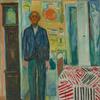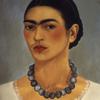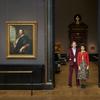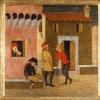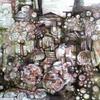Imperialism in Retrospect: In-Depth Exhibitions at Yale Explore British Marine Painting and Yinka Shonibare's Take on Lord Nelson
- NEW HAVEN, Connecticut
- /
- September 06, 2016
This fall, the Yale Center for British Art presents two comprehensive exhibitions.
Yinka Shonibare MBE (RA)
September 1–December 11, 2016
One is a special installation of works by contemporary British Nigerian artist Yinka Shonibare MBE (RA) (b. 1962), best known for his explorations of the legacies of colonialism through sculpture, installation, film, and photography.
The display focuses on Shonibare’s interest in the British historical figure Admiral Lord Nelson (1758—1805), whom he uses as an emblem of Britain’s imperial history. An important feature of Shonibare’s work is his consistent use of colorful, wax-printed cotton fabrics, which are associated with Africa but originated in Indonesia and Holland. A product of global trade and imperial markets, the fabric brilliantly captures the themes at the heart of Shonibare’s work.
The installation includes the original scale model of Nelson’s Ship in a Bottle, unveiled in 2010 in Trafalgar Square, which Shonibare produced for his commission as part of Britain’s “Fourth Plinth” series. Since 1999, the “Fourth Plinth” has provided a space dedicated to contemporary art commissions, and Shonibare’s was the first commission in the series granted to a black artist. It was also the first to engage directly with the history of the square, which commemorates Britain’s naval victory at the Battle of Trafalgar. Captured within a gigantic glass bottle, Nelson’s Ship in a Bottle is a representation of HMS Victory, Nelson’s famous flagship at the Battle of Trafalgar, the campaign in which the admiral heroically lost his life. Shonibare’s model ship accurately replicates HMS Victory, but its thirty-seven sails are made from his signature Dutch wax fabrics. Nelson’s Ship in a Bottle marked the beginning of Shonibare’s exploration of Nelson’s image and reputation beyond his death.
Spreading Canvas: Eighteenth-Century British Marine Painting
September 15–December 4, 2016
Spreading Canvas is the first major exhibition to survey the tradition of marine painting that was inextricably linked to Britain’s rise to prominence as a maritime and imperial power and to position the genre at the heart of the burgeoning eighteenth-century British art world.
Over the course of the eighteenth century, Britain vied with its main rivals—Holland, Spain, and France—for dominion over the seas. From thundering naval engagements to tranquil coastal scenes; from stormy shipwrecks to detailed views of working life in dockyards and on rivers; and from native shores to the farthest reaches of the globe, marine painting helped to tell the stories of the nation’s successes and disasters. Dominic Serres’s Capture of Chandernagore (National Maritime Museum, Greenwich, London) depicts a decisive episode in the establishment of British control in India, the capture of the French administrative outpost in Bengal in 1757. British naval ships are shown bombarding the town, one of them flying a red flag, the signal to engage.
By examining marine paintings alongside other media, including preparatory sketches, letters, and spectacular models such as the Coronation, Spreading Canvas illuminates the artistry involved in their making and recovers the meanings they conveyed to eighteenth-century viewers.
The exhibition is arranged in thematic sections within a broadly chronological framework. It begins with the arrival in England of the Willem van de Veldes (father and son), the Dutch painters who were given a studio at the Queen’s House in Greenwich and paid to depict “sea fights.” Willem van de Velde the Elder made studies of British naval vessels and maneuvers. He also made panoramic drawings of events such as the firework display on the Thames that celebrated the coronation of James II, in 1685, when according to one contemporary observer, “London seemed to have disembogued and emptied its Inhabitants into the Boats and onto the Shoars of the Thames.” The sheets that make up one of those views, long separated in the collections of the Yale Center for British Art and the National Maritime Museum, are reunited in this exhibition.
In the early eighteenth century, the prolific oeuvre of the Van de Velde studio—their hundreds of drawings, in particular, but also prints after their paintings—were collected and used as models by British artists. Marine painters such as Peter Monamy, Charles Brooking, and Samuel Scott were central to the art world that included William Hogarth, Thomas Gainsborough, and Richard Wilson; their works were shown together at the first public displays of art in London in the 1740s and at the first public exhibitions in the 1760s. In Spreading Canvas, Scott’s fascinatingly detailed The Thames and the Tower of London (1771) is shown alongside selections from a series of his large sketches made along the river. His connection with Hogarth is demonstrated in an illustration from The Five Days’ Peregrination, which recounts a rowdy outing taken by the two artists and their friends. The illustration shows Scott sketching ships at anchor in the river while his
companions converse.
Naval officers commissioned artists to paint the battles in which they had fought, and sometimes made their fortune. The exhibition includes annotated sketches and letters that reveal the ways in which officers often worked with artists to ensure that the details of events—the number of ships involved, the direction of the wind, the damage sustained to masts, spars, rigging, and sails at a given point in the action—were accurately depicted in the finished paintings. These were the conditions under which the British navy achieved
its victories, and the paintings would represent these victories for posterity.
Samuel Scott’s Vice Admiral Sir George Anson’s Victory off Cape Finisterre (1749), still in its original trophy frame, is one of a suite of paintings by the artist that depict events in the illustrious career of Admiral George Anson. It includes a wealth of visual detail that convinces the viewer of its accuracy but also compresses the events of the action such that a narrative unfolding over several hours appears in a single, unified painting.
The painting is featured in a section of the exhibition inspired by a letter written by Anson’s wife, Lady Elizabeth Yorke Anson, to her sister-in-law. It describes the arrangement at Shugborough, the house belonging to Anson’s elder brother, of objects relating to Anson’s exploits; “[T]he whole will be a kind of history,” writes Lady Anson.
The exhibition evokes the arrangement at Shugborough through a display of objects listed in her letter: Scott’s paintings of Anson’s naval victories; the model of the Centurion, the ship in which Anson sailed around the world in 1740–44; and a set of prints published in 1748 that illustrate the account of Anson’s voyage.
Through unique groupings of objects like these, the exhibition reconstructs the full array of representational modes—pictorial, planimetric, narrative, and plastic—that were deployed throughout the century to represent the maritime exploits of the nation. Moreover, Shugborough not only provides a rare example of the ways in which marine paintings were displayed in domestic settings but also highlights the frequent role played
by naval wives, specifically in the commissioning and display of marine paintings and in the promotion of their husbands’ reputations.
However, their insistence on accuracy and the convincing level of detail have caused these paintings to be treated more as reportage than as works of art. By including examples of the sketches, plans, and textual accounts that underlay the finished works, Spreading Canvas reveals the processes through which marine painters constructed depictions of highly complex events that had taken place over great distances and lengths of time.
The exhibition includes the materials gathered by the marine painter Nicholas Pocock as preparation for the Battle of the Glorious First of June in 1794, the first naval battle of the French Revolutionary War. The resulting, extraordinarily grim, portrayal of one of the bloodiest engagements of the battle, eloquently evokes the heroic demise of the commander of the Brunswick, his bodily sacrifice translated into a struggle to the death between two ships.
Spreading Canvas also examines the interest of artists and the then print-buying and exhibition-going public in views of British coastlines, the first line of defense for an island nation, and of colonial and imperial forts and settlements. Charles Brooking’s Shipping in the English Channel (ca. 1755) is both a celebration of British sea power and trade in a location of geopolitical significance and a lyrical evocation of early morning
light and atmosphere.
The exhibition concludes with marine painters’ responses to the artistic revolutions of the 1790s in which early modern ways of depicting and knowing became eclipsed by new modes of representation and exhibition. These included the panorama and other forms of large-scale, popular scenic entertainment; public exhibitions devoted to single works of art; and the arrival on the scene of J. M. W. Turner, who in responding to his British contemporaries as well as his Dutch predecessors, explored new ways of engaging artistically with the sea.
Drawn primarily from the collections of the Yale Center for British Art and augmented by unparalleled loans from public and private collections, Spreading Canvas demonstrates that marine painting was both ubiquitous and fundamental to eighteenth-century British culture.

